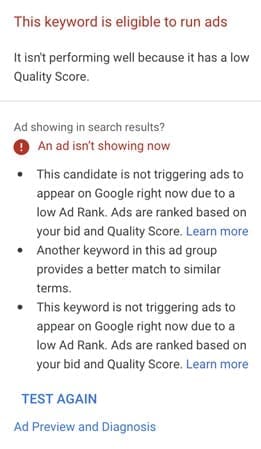
Your PPC Ad Quality Score is vital to the success of your campaigns and is a major factor in ROI. However, many businesses don’t even know it exists until they get an error saying their ads aren’t displaying because of it, or they stumble upon it by accident.
On this page, we’ll walk you through how your Quality Score is calculated, all the things it impacts, what score you should strive for, and how to make improvements if you’ve gotten a Quality Score error or want to improve your PPC campaign results.
What is a Quality Score for PPC?
Let’s start with the basics: what is Quality Score in PPC? These are the scores platforms like Google Ads and Microsoft Advertising assign to you at a keyword level that indicates the type of user experience your ads provide. Your score will fall anywhere between one and ten. A one is a low Quality Score, and a ten is the highest possible score.
You’ll see something like the image below if you’re in your Google Ads account and looking at your keyword-level metrics.

If you don’t see a “Quality Score” column, add it by clicking the “Columns” option in the toolbar. “Quality Score (hist.)” is also an option.
The Quality Score column tells you how you’re performing right now. The “hist.” means “historical.” It’s helpful if you’re taking steps to improve your Quality Score and want to see how your scores compare.
Why Your Ad Quality Score Matters
We’ve all had good and bad experiences viewing ads online. A bad experience doesn’t provide value and feels intrusive. A good experience benefits us and feels more like a natural extension of browsing. Good experiences keep us happy and clicking. Bad experiences make us wary of clicking and discourage us from engaging with ads in the future. Paid advertising platforms know this. Their profit depends on continued clicks, so they want to ensure advertisers provide an excellent experience. In support of this, they reward advertisers that have a good Quality Score.

Your Ad Might Not Display if the Quality Score is Low
PPC platforms hold auctions to determine which ads display and where each ad appears on the page. Whereas the highest bid wins in a traditional auction, PPC platforms look at various signals to determine who wins. Your PPC quality score is a factor. That means a low Quality Score can prevent your ad from winning auctions, or it may consistently rank so low that it never gets displayed. When this occurs, you’ll receive an error that says: “This keyword is eligible to run ads. It isn’t performing well because it has a low Quality Score.”
You Can Win Ad Auctions Even if You’re Not the Highest Bidder
While it may seem disappointing that even a top bid won’t necessarily guarantee that your ad displays if your Quality Score is low, there is an upside to this. You can win an auction and have your ad published even if you’re not the highest bidder.
Your Impressions and Clicks May Increase
In addition to having your ad published, platforms are more likely to display your ad higher on the page than other ads when you have a good score. This means you’re likely to see more impressions and clicks.
Your Cost Per Click (CPC) Will Be Lower
Because you can win auctions with lower bids, a high Quality Score can help decrease your cost per click.
Your PPC ROI Skyrockets
These factors mean you get more clicks for less money, increasing your ROI.
What is a Good Ad Quality Score?
You want the highest ad Quality Score possible. A “good” score is one that beats your competitors or at least allows you to be competitive. Because you can’t know their scores, however, having some general guidelines may help.
Ad Quality Score Benchmarks
- Branded Keywords: 8-10
- High-Intent Commercial Keywords: 7-9
- Low-Intent Commercial Keywords: 7
- Competitor Keywords: 3+
What Determines Your Ad Quality Score
While each paid advertising platform may have slightly different criteria, your Quality Score is based on three components, according to Google: Expected CTR, Ad Relevance, and Landing Page Experience. Google provides you with one of three ratings in each category:
- Above average
- Average
- Below average
Because scores are assigned at a keyword level, all three can be viewed in your Google Ads account in the Search Keywords section. If you don’t see them displayed, click “Columns” in the toolbar and search for them or look in the “Quality score” section.
You can also view historical data, which can be helpful if you’re making improvements and want to see if and how they’ve impacted your scores.

1. Expected Clickthrough Rate (CTR)
Your expected clickthrough rate (CTR) is Google’s prediction of how likely your ad will be clicked when shown with a specific keyword.
Note: It’s ok to have a low expected clickthrough rate sometimes. For instance, if you run a travel agency specializing in high-end vacations, you might run an ad that says “Luxury Destinations.” The wording will resonate with your audience and reduce clicks and costs because bargain shoppers aren’t likely to click.
2. Ad Relevance
Ad Relevance is a measure of how closely an ad matches user intent.
3. Landing Page Experience
Your Ad Quality Score’s third and final component is your landing page. Google considers both relevancy and usefulness to the user.
How to Improve Your PPC Quality Score
Now that you have the background, let’s go over how to improve Google Ad Quality Score. Everything ties back to making improvements in one or more of the three areas covered above: Expected CTR, ad relevance, and landing page experience.
Build a Journey Around User Intent
User > Intent > Keyword > Ad Copy > Landing Page

The customer journey will be disjointed if your ads are built without considering where the person is coming from and where they’re going. Each asset you create should flow together.
For example, maybe the PPC persona you’re building a journey for is a small business owner who needs funding but doesn’t have great credit. They’re going to use the search term “business loan no credit” to try to find out what their options are. So, you’ll include that keyword in your campaign, then draft ad copy around it. You only get 30 characters for a Google Ad heading, so you might start with “Business Loan; No Credit Req’d” as your heading. Then, your landing page will have an H1 heading: “Qualify for a Business Loan – No Credit Needed.”
Carrying the keyword through helps reinforce that your business solves the person’s problem. It also increases the likelihood of a click on the ad, boosts relevance, and helps improve the landing page experience.
Prune or Regroup Your Keywords
Because Quality Scores are assigned at the keyword level, finetuning your keywords is an easy way to make improvements.
Start by removing keywords that don’t match the user intent you want to work with or the journey you created. For instance, if you’re running an ad campaign to encourage people to sign up for your business loans but use generic keywords like “loans” and “cash advance,” remove those words.
Next, examine your keyword groups. Let’s say that your ad group that contains the keyword “business loan no credit” also contains:
- Business loan bad credit
- Asset-based business loan
- Collateral-based business loan
Even though people using those search terms may all be satisfied with the same solution, they’re going into it with a different mindset. Moreover, it’s challenging to tailor both the ad and landing page to the keywords when they’re that unique. It’s better to spin the “asset-based” and “collateral-based” terms off into their own group so you can ensure the journey is consistent and that your messaging is relevant.
Revamp Your Ad Copy
Expected CTR and ad relevance both hinge on having strong ad copy. In addition to building yours around the keywords, try to make your ads more compelling. For instance, try using power words, statistics, and numbers. Include a call-to-action (CTA) that explains why they should click and offers an incentive to do so.
Optimize Your Landing Pages
The landing page experience is the final factor in your ad Quality score. This includes factors such as:
- A compelling headline with the keyword in it
- Including the keyword in the copy
- Breaking up the copy in a way that’s easy to digest
- Eye-catching visual aids
- A Click-worthy high-contract CTA
- Trust symbols
- Fast load speeds
- Mobile-friendliness
Run A/B Tests
Keep running tests on your headlines, ad copy, CTAs, and landing pages. Each test you run will tell you a little more about your audience’s preferences.
Improve and Monitor
Schedule time to review the results each time you make improvements. Make a note of your Ad Quality Score and your Expected CTR, Ad Relevance, and Landing Page Experience scores which contribute to it. That way, you can roll back any changes that have had a negative impact with relative ease and can keep implementing positive changes to improve your score.
Get Help Boosting Your PPC Ad Quality Score
As you can see, a lot goes into having a high PPC Ad Quality Score. If you’re struggling to get yours where it needs to be or want help with your campaigns, we’re happy to connect you with an expert. Request a complimentary PPC consult to get started.


















